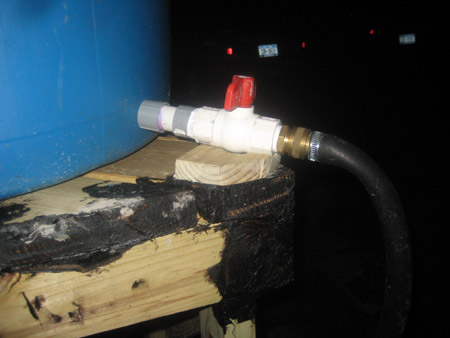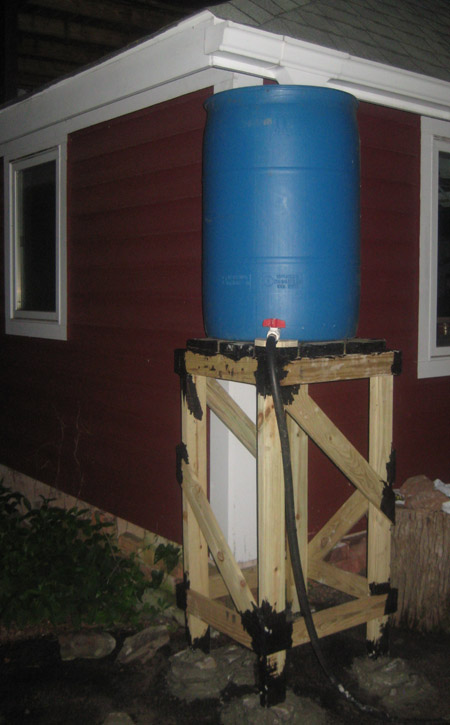|
|
|
ball valve luxury
Friday, June 17 2011
Yesterday, in anticipation of setting it upon the new tower I'd built, I'd drained the 55 gallon tank used to collect water at the northwest corner of the house. I'd hoped to have that tank installed in its new home before the next rains, but unfortunately those rains fell last night and seemed to be over by this morning.
Today I prepared the tank for its new life on the tower. I cut its top off, cut a 3/4 inch hole near its bottom and cut threads into that hole. Then, using 3/4 PVC pipe and two 3/4 inch male PVC threaded fittings, I made a little stem with which to attach a 3/4 inch ball valve, which would hopefully give me a much higher flow rate than a simple half inch drain tap.
I put the tower in place, used rocks to level its legs, and then put the tank atop it. The rocks weren't a great fit and seemed a little unstable, so I mixed up some mortar to solidify the footings.
I wanted to try out the 3/4 inch tap, so I dumped some water in the tank and gave it a try. It produced water at a significantly faster rate than the household's plumbing, so it looked like I had a winning system. (Ball valves open up a much larger diameter of flow aperature than the screw-handle valves one normally encounters.)
Next I was thinking about replacing the faucet tap on the woodshed's water tank with a similar ball valve system, but to do that I'd have to drain all that water away. That water was valuable; I didn't want to simply waste it. Ideally, I'd use it to fill the new water tank. But carrying 55 gallons from one tank to another is hard work, particularly when the water must be dumped into the recipient tank at a height of about seven feet. It would be easiest to run a hose from the woodshed tank down to the northwest corner tank, which is conveniently downhill. The problem was that I didn't have a long enough hose. Fortunately, though, there was a solution. All I had to do was run the hose down to the south end of the gutter that drains into the northwest tank, and gravity would take it from there. Once I had this ingenious system in place and filling the northwest tank, I realized that the problematic limit to flow from the woodshed tank wasn't its drainage tap, it was the spray fitting I'd attached to the hose coming from it. With that fitting out of the way, it drained at an acceptable rate. So now I realized I didn't need to add a ball valve on the woodshed tank. Sure, it was a nice luxury for the northwest tank, but I could get acceptable flows without it. And, since clouds had rolled in and rain had begun to fall, it seemed it was best to just let the northwest tank fill on its own, since it had a much larger roof feeding it than the woodshed tank does.
Another project I undertook today was to assemble the pieces of the linear parabolic WiFi kit I'd like to have available for use when traveling with my laptop. The main task here was to download a suitable parabolic template and then use it to cut out a parabolic slot in a piece of plexiglass. I printed out a good template, glued it onto the plexiglass with rubber cement, and then cut out the slot in the drill press using a Dremel bit as a sort of rotating saw.

3/4 inch tap and other hardware necessary to get water quickly out of the bottom of the northwest tank. The block of wood beneath it gives it some support and provides strain relief for when it is attached to a hose.

The northwest tank on its new tower.
For linking purposes this article's URL is:
http://asecular.com/blog.php?110617 feedback
previous | next |

